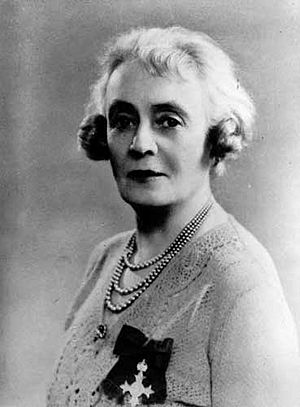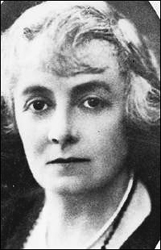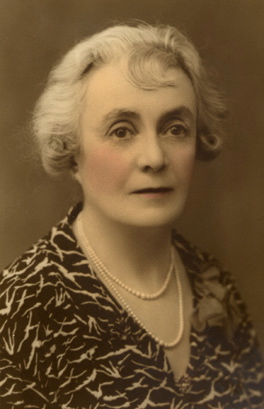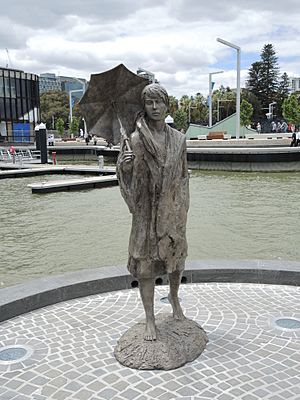Bessie Rischbieth facts for kids
Bessie Mabel Rischbieth (born 16 October 1874 – died 13 March 1967) was an important Australian social activist. She worked to improve society and fought for women's rights. She helped start many groups, like the Women's Service Guilds and the Australian Federation of Women Voters. These groups aimed to make big changes for human rights around the world.
Bessie is also remembered for a brave protest in 1959. At 85 years old, she stood in the river to stop bulldozers from filling in Mounts Bay in Perth. This action helped bring attention to protecting nature.
Contents
Early Life
Bessie Mabel Earle was born in Adelaide, South Australia. She grew up on a farm in Burra, South Australia. Her parents were William and Jane Anna Earle.
Later, Bessie and her sister moved back to Adelaide for school. They lived with their uncle, "Ben" Rounsevell, who was a politician. He helped Bessie think about social issues.
She went to the Advanced School for Girls in Adelaide. At home, she often discussed important topics like women's rights. South Australia was the first Australian state to let women vote. This meant Bessie was one of the first women who could vote there.
Marriage
In 1898, Bessie married M. Henry Wills Rischbieth, who was a wool merchant. They moved to Peppermint Grove, Western Australia. From 1904, they lived in a house called Unalla House.
Bessie's husband was a successful businessman. Bessie and Henry did not have children. This led Bessie to focus her energy on helping children and working for social change. She became a key figure in the women's rights movement.
Career
In 1906, Bessie helped start the Children's Protection Society in Western Australia. In 1909, she joined the Women's Service Guilds.
Bessie and her husband traveled to Japan and India. They also stayed in London around 1913. At this time, women's right to vote (called suffrage) was a huge topic in Britain. There were big protests and debates.
Bessie heard Emmeline Pankhurst speak about women's rights. She wrote to her sister, saying she felt stronger and braver after hearing her.
After this, Bessie became a very active supporter of women's rights. She helped create the Australian Federation of Women's Societies (AFWV) in 1921. She became its first President.
In 1915, Bessie was given an honorary role at the Perth Children's Court. She worked there for 15 years. She was also the first woman to become a Justice of the Peace at the Perth Court. This happened after a successful effort to change old laws that stopped women from serving on the court.
Bessie believed that mothers had important political rights. In 1923, the government tried to cut the Maternity Allowance (money given to new mothers). Bessie spoke out strongly against this. She said that decisions about mothers should involve the mothers themselves.
Bessie held many important roles. She was a vice-president of the British Commonwealth League of Women's from 1925. She also helped start the Western Australian Women Justices' Association. She co-founded the Women's Non-party Political Association.
She joined the board of the International Alliance of Women for Suffrage and Equal Citizenship. In 1928, she led the Australian group to the Pan-Pacific Women's Conference in Honolulu. She also pushed for women to be part of Australia's group at the League of Nations, and she was appointed to it.
Bessie worked on many issues for women and children. This included the welfare of Indigenous Australians. In 1934, she spoke to a special commission. She asked them to look into the practice of taking Indigenous children from their parents. She told Prime Minister Joseph Lyons that Australia had a duty to Indigenous people under the League of Nations agreement.
During the war, Bessie was in England. She set up a place called World for Australian servicemen at Australia House. Bessie was president of the Women's Service Guilds of Western Australia again from 1946 to 1950. This group helped create projects like a maternity hospital (King Edward Memorial Hospital for Women) that accepted single mothers.
The Women's Service Guilds published a journal called Dawn. Bessie was its first editor and wrote for it often. In 1955, she became a life member of the International Alliance of Women for Suffrage and Equal Citizenship.
Later in her life, Bessie had public disagreements with another activist, Jessie Street. Even though they had different political ideas, they often worked together on issues like women's rights, Indigenous Australians, and peace. Bessie was given an OBE award in 1935 for her work with women's movements. She also helped start the Kindergarten Union of Western Australia, which provided free preschool education.
Civic Life and the Arts

Bessie Rischbieth never ran for political office herself. However, she supported Edith Cowan's successful election campaign. She often spoke directly to leaders about civil rights and protecting nature. She wrote to Prime Ministers like Joseph Lyons, John Curtin, and Robert Menzies. Her important position meant that powerful people listened to her.
Bessie was a member of the Karrakatta Club. She also showed her artwork at the West Australian Society of Arts. Her book, The March of Australian Women (1964), was a detailed look at the women's rights movement in Australia. Bessie was a strong supporter of good city planning and protecting natural places.
Bessie was also part of the Theosophical movement. This group often worked with feminists and conservationists in Australia. She was a Co-Freemason, which was also linked to Theosophy. She traveled to Asia and was interested in Eastern ideas. She even stayed at Mahatma Gandhi's ashram once.
Last Years
Bessie helped create a group called the Citizens Committee for the Preservation of Kings Park and the Swan River. This group successfully stopped an Olympic swimming pool from being built in Kings Park for the 1962 Empire Games.
When the Narrows Bridge was being built, Bessie was almost 90 years old. She bravely tried to block the construction by standing in the river in front of bulldozers. This act was reported in the newspaper. It started a big public discussion about development, even though it didn't stop the land from being filled in.
Death
Bessie Rischbieth continued to be active in social issues until she died. She passed away at Bethesda Hospital in Claremont, Western Australia, on 13 March 1967, at the age of 92.
Legacy
The Women's Service Guilds, which Bessie helped lead, were very important. They helped start many other groups. These include the National Council of Women of Australia, Girl Guides, the Housewives Association, and groups for conservation of the Swan River. These groups worked to help women and children across Australia.
Bessie Rischbieth is often named in The West Australian newspaper's list of "W.A.'s 100 most influential" people. A conservation award is named after her.
Many of her papers and other materials are kept in important libraries. These include the National Library of Australia and the State Library of Western Australia. In 2016, the National Library of Australia asked for donations to make her papers available online.
In 2016, a statue of Bessie was placed at Elizabeth Quay in Perth. The statue shows her protest against filling in Mounts Bay.
Rischbieth Crescent, a street in the Canberra suburb of Gilmore, is named in her honor.
Images for kids
-
YWCA, Bessie Rischbieth Centre, January 1930.
Published Works
- The Dawn, journal of the Federation of Women Voters









